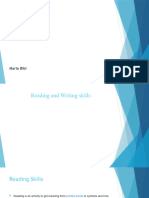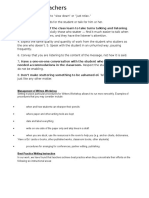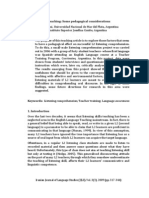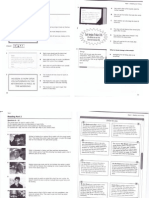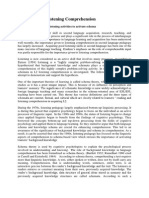0 ratings0% found this document useful (0 votes)
102 viewsNature and Purpose of Writing
Nature and Purpose of Writing
Uploaded by
api-583845111The document discusses the nature and purpose of writing. It defines writing as the encoding of messages through symbols like letters and words to communicate ideas to readers. Writing is difficult because it involves complex mental processes like drafting, editing and organizing ideas. The document also outlines different approaches to teaching writing, including the controlled-to-free approach, free writing approach, paragraph pattern approach, grammar-syntax organization approach, communicative approach and process approach.
Copyright:
© All Rights Reserved
Available Formats
Download as PDF, TXT or read online from Scribd
Nature and Purpose of Writing
Nature and Purpose of Writing
Uploaded by
api-5838451110 ratings0% found this document useful (0 votes)
102 views21 pagesThe document discusses the nature and purpose of writing. It defines writing as the encoding of messages through symbols like letters and words to communicate ideas to readers. Writing is difficult because it involves complex mental processes like drafting, editing and organizing ideas. The document also outlines different approaches to teaching writing, including the controlled-to-free approach, free writing approach, paragraph pattern approach, grammar-syntax organization approach, communicative approach and process approach.
Original Title
nature and purpose of writing
Copyright
© © All Rights Reserved
Available Formats
PDF, TXT or read online from Scribd
Share this document
Did you find this document useful?
Is this content inappropriate?
The document discusses the nature and purpose of writing. It defines writing as the encoding of messages through symbols like letters and words to communicate ideas to readers. Writing is difficult because it involves complex mental processes like drafting, editing and organizing ideas. The document also outlines different approaches to teaching writing, including the controlled-to-free approach, free writing approach, paragraph pattern approach, grammar-syntax organization approach, communicative approach and process approach.
Copyright:
© All Rights Reserved
Available Formats
Download as PDF, TXT or read online from Scribd
Download as pdf or txt
0 ratings0% found this document useful (0 votes)
102 views21 pagesNature and Purpose of Writing
Nature and Purpose of Writing
Uploaded by
api-583845111The document discusses the nature and purpose of writing. It defines writing as the encoding of messages through symbols like letters and words to communicate ideas to readers. Writing is difficult because it involves complex mental processes like drafting, editing and organizing ideas. The document also outlines different approaches to teaching writing, including the controlled-to-free approach, free writing approach, paragraph pattern approach, grammar-syntax organization approach, communicative approach and process approach.
Copyright:
© All Rights Reserved
Available Formats
Download as PDF, TXT or read online from Scribd
Download as pdf or txt
You are on page 1of 21
Nature and Purpose or Writing
(MB & YN)
What is writing?
• “When we write we use graphic symbols that
is letters or combinations of letters which
relate to the sounds we make when we
speak.” (Byrne, 1979)
What is writing?
Communicating ideas
• Symbols
• Words
• Sentences
What is writing?
• encoding of a message
• we translate our thoughts and ideas into
language
• writing represents our thoughts and ideas
• what one thinks leads to one’s writing in the
form of sentences and by organizing the
sentences into a cohesive text where we are
able to communicate with our readers
successfully
Why is writing difficult?
• writing always has become difficult to teach or
to learn because it involves a different kind of
mental process which includes the sub-skills
like – drafting, editing, revising, organising
Speech and Writing
• Speaking • Writing
• use a variety of prosodic - powerful mode of
features such as pitch, communication
loudness, speed, rhythm, • is not always for the
pauses and so on audience present and hence
• get the feedback from it demands clear and
listeners comprehensive message
• that help us to but this does • the context is created
not happen in case of through the words alone
writing where and without the direct
interaction between the
writer and the reader
Three Main Aspects of
Writing(PAF)
1. Purpose/Objective
2. Audience/Readers
3. Function
Purpose/Objective
• a text is always written with a purpose or
objective Am I writing with any special
purpose?
• Or
• Why am I writing?
• The answers to these questions will make the
idea clear and can bring out a good piece of
writing
Audience/Readers
• communication is meant for expressing ideas
from one to one
• in case of writing, the audience is not present
but at least if the writer wants, S/he can write
keeping the target group in mind
Audience/Readers
• "Who, is going to read?"
Or
• " For whom am I writing?" has to be made
clear.
• one should be clear for the audience or the
readers either they are teachers or students
or any other because after all this decides the
nature of writing
Function
• function decides the nature of writing (a
report, a letter, or just a write-up)
• covered under one word i.e. " to plan" - to
prepare oneself for writing
• "Failing to prepare is preparing to fail"
- which again shows the importance of
preparation or planning
For planning writing
1) What is my objective of writing?
2) What are the main idea and the supporting
ideas?
3) Who is going to read my written text?
4) For which specific function am I writing?
5) Which idea should come first?
6) How should I organize all ideas?
Rules of Thumb for Teaching
Writing
1) Consider the needs of the Learners
2) Make the teaching of writing functional and communicative
3) Expose them to how to write first and then to different types of texts
4) Expose them to functioning of writing as a system of communication
5) Try to plan the tasks which are realistic, functional and
communicative
6) Expose them to the process of writing by actually going through it,
including the sub skills of writing
7) Motivate them to think and express their ideas
8) Teach them grammar and vocabulary inclusively in the writing tasks
9) Try to accept their ideas and also compositions
Approaches to Writing
• The Controlled to Free Approach
• The Free Writing Approach
• The Paragraph Pattern Approach
• The Grammar-Syntax Organization Approach
• The Communicative Approach:
• The Process Approach
The Controlled to Free Approach
• 1950s and early 1960 the audio- lingual method
dominated second language learning
• it emphasizes on speech and writing through
mastering grammatical and syntactic forms
• students are given sentence exercises, then
paragraphs to copy or manipulate grammatically,
• these controlled compositions then followed by
correction of errors, so that it can lead to the free
composition
• this approach focuses on accuracy rather than
fluency
Controlled to Free Approach
The Free Writing Approach
• stresses writing quantity rather than quality
• focuses on fluency rather than accuracy
• based on the principle that if once ideas are
there, the organisation follows
The Paragraph Pattern Approach
• This approach focuses on organisation by
copying the paragraphs or model passages
• based on the principle that in different culture
or situations, people construct and organise
communication with each other in different
ways
The Grammar-Syntax Organization
Approach
• stresses on simultaneous work on more than
one composition feature
• it is inclusive here that writing cannot be seen
as composed of separate skills which are
learned sequentially
• students must be trained to pay attention to
organization while they also work on the
necessary grammar and syntax
The Communicative Approach
• focuses on the purpose of writing and the audience
for it
• students are given some tasks where they have to
behave as writers so that they can learn by doing it
- Why am I writing this?
- Who will read it?
• this approach is quite functional in nature, which can
provide the actual experience to the learners
The Process Approach
• shows the shift from product to process which shows:
• - how do I write this?
• - how do I get started?
• students are trained to generate ideas for writing, to think of
purpose, audience, ways of communication and so on
• it's a developmental process from generating ideas to
expressing them, drafting, redrafting, organizing and so on
• the process of writing can have three stages like:
- Prewriting
- Writing
- Post-writing (Revising or Redrafting)
You might also like
- Through the Looking-Glass, and What Alice Found There: Unabridged with the Original Illustrations by John TennielFrom EverandThrough the Looking-Glass, and What Alice Found There: Unabridged with the Original Illustrations by John TennielNo ratings yet
- Oral Communication in the Disciplines: A Resource for Teacher Development and TrainingFrom EverandOral Communication in the Disciplines: A Resource for Teacher Development and TrainingNo ratings yet
- A Brief History of Badminton from 1870 to 1949From EverandA Brief History of Badminton from 1870 to 1949Rating: 3.5 out of 5 stars3.5/5 (2)
- A Study Guide for Nadine Gordimer's "Once Upon a Time"From EverandA Study Guide for Nadine Gordimer's "Once Upon a Time"Rating: 5 out of 5 stars5/5 (1)
- The Importance of Developing Reading for Improved Writing Skills in the Literature on Adult Student's LearningFrom EverandThe Importance of Developing Reading for Improved Writing Skills in the Literature on Adult Student's LearningNo ratings yet
- Crisscrossing Through Afro-Asian LiteratureFrom EverandCrisscrossing Through Afro-Asian LiteratureRating: 5 out of 5 stars5/5 (4)
- Effective Feedback (Imprimible)Document34 pagesEffective Feedback (Imprimible)Candelaria LuqueNo ratings yet
- Communication ApproachesDocument18 pagesCommunication ApproachesIshitpratap ChandNo ratings yet
- Developing Learners' Writing SkillsDocument20 pagesDeveloping Learners' Writing SkillsMariaNo ratings yet
- Teaching WritingDocument66 pagesTeaching WritingAGUSTIN VIVIAN MAENo ratings yet
- UEU TEFL Methodology 13Document45 pagesUEU TEFL Methodology 13bauyonanchieNo ratings yet
- Teaching Written Expression To Students With Special Needs: Sped 620 BrownbridgeDocument48 pagesTeaching Written Expression To Students With Special Needs: Sped 620 BrownbridgeLucia NinoNo ratings yet
- Writing Skills by Forkan AhmadDocument16 pagesWriting Skills by Forkan Ahmadeshakhancollege52No ratings yet
- Writing SkillsDocument23 pagesWriting SkillsAreeba KhanNo ratings yet
- كتابة تقارير 1Document74 pagesكتابة تقارير 1mahan108na9No ratings yet
- Teaching WritingDocument30 pagesTeaching WritingGerand BuenaobraNo ratings yet
- The Four Skills of Language LearningDocument27 pagesThe Four Skills of Language Learningkhalilrif2000No ratings yet
- TSL 592 Methodology of Teaching WritingDocument20 pagesTSL 592 Methodology of Teaching WritingFatin Hamimi100% (1)
- (Lecture Note) Your Writing ExperienceDocument14 pages(Lecture Note) Your Writing ExperiencePhuong VuNo ratings yet
- Writing SlidesDocument30 pagesWriting SlidesdaliaNo ratings yet
- 1.teaching Writing IntroductionDocument38 pages1.teaching Writing IntroductionnadeendalolNo ratings yet
- The Elements of The Reading and WritingDocument11 pagesThe Elements of The Reading and WritingnursyilaaliudinNo ratings yet
- Leah Curriculum of WritingDocument17 pagesLeah Curriculum of Writingapi-264912742No ratings yet
- PPT-How Writers WriteDocument10 pagesPPT-How Writers WriteSplendidgodNo ratings yet
- Teaching Writing: Realin Packit Escanilla Acosta EllazarDocument45 pagesTeaching Writing: Realin Packit Escanilla Acosta EllazarMica Kimberly UrdasNo ratings yet
- TLS - Lecture 2 - 20.9.23Document27 pagesTLS - Lecture 2 - 20.9.23Hijab BatoolNo ratings yet
- Teaching Writing 1Document21 pagesTeaching Writing 1ilyas khanNo ratings yet
- Dealing With Writing SkillsDocument56 pagesDealing With Writing Skillsiffah marzukiNo ratings yet
- Inspiring Interpretive Instruction APAC 2017: Presented by Ed WeissDocument79 pagesInspiring Interpretive Instruction APAC 2017: Presented by Ed WeissshsT TNo ratings yet
- ELT 105 Teaching ReadingDocument15 pagesELT 105 Teaching ReadingJewel OrtizNo ratings yet
- Wefbwefuohwef Iiwef Iiwejfbouhwejfohwefnowe FwefDocument13 pagesWefbwefuohwef Iiwef Iiwejfbouhwejfohwefnowe Fwef刘欣No ratings yet
- Teaching of WritingDocument10 pagesTeaching of WritingEllaine GraceNo ratings yet
- Lesson PlanningDocument32 pagesLesson PlanningAiman AzizanNo ratings yet
- Writing StrategiesDocument43 pagesWriting StrategiesENo ratings yet
- Philosophy of LiteracyDocument2 pagesPhilosophy of Literacyapi-506353226No ratings yet
- Session 3, English Teaching MethodsDocument46 pagesSession 3, English Teaching MethodsĐỗ Quỳnh TrangNo ratings yet
- 8 Tips For Teachers: Needed Accommodations in The Classroom. Respect The Student's Needs, ButDocument6 pages8 Tips For Teachers: Needed Accommodations in The Classroom. Respect The Student's Needs, ButRishabh Madhu SharanNo ratings yet
- An Intro To Multimodal Texts: Writer/Designer: A Guide To Making Multimodal Projects (Chapter 1)Document15 pagesAn Intro To Multimodal Texts: Writer/Designer: A Guide To Making Multimodal Projects (Chapter 1)writingcenterNo ratings yet
- PPP Week 1Document24 pagesPPP Week 1api-649700352No ratings yet
- 01 Teaching Reading & Writing Education at Primary Level-1Document41 pages01 Teaching Reading & Writing Education at Primary Level-1Nazeeha IhshanNo ratings yet
- The Writing Process and Creative Writing PDFDocument67 pagesThe Writing Process and Creative Writing PDFMar CrespoNo ratings yet
- Modelled WritingDocument2 pagesModelled WritingMaria MandezNo ratings yet
- El 101 Reviewer # 2Document23 pagesEl 101 Reviewer # 2grantus.aljunNo ratings yet
- Teaching Productive SkillsDocument25 pagesTeaching Productive Skills7hyjw72ky7No ratings yet
- Effective Writing SkillsDocument22 pagesEffective Writing SkillsMuhammad AliNo ratings yet
- ENGL 157: Communication Skills (I) : Lecture 1:introduction and Overview of The CourseDocument12 pagesENGL 157: Communication Skills (I) : Lecture 1:introduction and Overview of The Coursenana kwameNo ratings yet
- C1L3 Techniques in Selecting and Organizing InformationDocument50 pagesC1L3 Techniques in Selecting and Organizing InformationMichiyaNo ratings yet
- Academic Writing Lecture OneDocument33 pagesAcademic Writing Lecture OnethegodofthebladeNo ratings yet
- Teaching Writing in Interactive EnglishDocument29 pagesTeaching Writing in Interactive EnglishjhoeyaxNo ratings yet
- Teaching WritingDocument6 pagesTeaching WritingNurul AinNo ratings yet
- Effective Communication and Writing in English...Document16 pagesEffective Communication and Writing in English...TikTok vs AnimeNo ratings yet
- Module 3 Business CommunicationDocument31 pagesModule 3 Business CommunicationSuresh GowdaNo ratings yet
- Instructional Approachesfor Teaching WritingDocument13 pagesInstructional Approachesfor Teaching Writingnurainurlanovna6No ratings yet
- Introduction To WritingDocument17 pagesIntroduction To WritingElizier 'Barlee' B. LazoNo ratings yet
- APW - Day I PDFDocument26 pagesAPW - Day I PDFsampathkumarNo ratings yet
- Collaborative Learning Workshop: To Be Done During The Writing ProcessDocument2 pagesCollaborative Learning Workshop: To Be Done During The Writing ProcessshackneyjthsNo ratings yet
- The Teaching of Literature SlidesDocument66 pagesThe Teaching of Literature SlidesDino100% (1)
- Lesson Plan Mini Teaching-Faiqahs GroupDocument3 pagesLesson Plan Mini Teaching-Faiqahs Groupapi-583845111No ratings yet
- Assignment 1 Short Essay by Intan ArisyaDocument8 pagesAssignment 1 Short Essay by Intan Arisyaapi-583845111No ratings yet
- Assessing Written WorkDocument28 pagesAssessing Written Workapi-583845111No ratings yet
- General PrinciplesDocument29 pagesGeneral Principlesapi-583845111No ratings yet
- How Writte Language FunctionDocument10 pagesHow Writte Language Functionapi-583845111No ratings yet
- DELF Exam Dates Fees 2016Document1 pageDELF Exam Dates Fees 2016Arcadie CondreaNo ratings yet
- Bilingual and Multilingual Education Policies in NetherlandsDocument15 pagesBilingual and Multilingual Education Policies in Netherlandsjohn reyvin amaliasNo ratings yet
- Tema 5 Primaria InglesDocument13 pagesTema 5 Primaria InglesAnonymous J0V441No ratings yet
- Second Language Acquisition by Rod EllisDocument21 pagesSecond Language Acquisition by Rod EllisZakariaOudra93% (14)
- Ielts Collected Papers2 Paperback Frontmatter PDFDocument14 pagesIelts Collected Papers2 Paperback Frontmatter PDFAbera MamoNo ratings yet
- Moore 2018Document6 pagesMoore 2018210302110019No ratings yet
- Effects of The Language Barriers (Research Paper)Document20 pagesEffects of The Language Barriers (Research Paper)Abegail Beguiras100% (5)
- Bilingualism and Multilingualism, 445Document11 pagesBilingualism and Multilingualism, 445farraaniesyaNo ratings yet
- Listening Skills TeachingDocument28 pagesListening Skills TeachingYesid Páez Cubides100% (1)
- 1824 3642 1 SMDocument14 pages1824 3642 1 SMTuyết Phương Lê ThịNo ratings yet
- 21 Task-Based Language TeachingDocument43 pages21 Task-Based Language Teachingalwrafy100% (1)
- An Evaluation Plan For A Set of General English Course BooksDocument5 pagesAn Evaluation Plan For A Set of General English Course BooksSkand BhardwajNo ratings yet
- Bilingualism Michael Bermúdez Montes.Document1 pageBilingualism Michael Bermúdez Montes.Michael MontesNo ratings yet
- Factors Associated With Common Errors in English GrammarDocument7 pagesFactors Associated With Common Errors in English GrammarJude SanchezNo ratings yet
- The Cambridge Handbook of Korean Linguistics: SungdaichoDocument1,035 pagesThe Cambridge Handbook of Korean Linguistics: SungdaichoNot RealNo ratings yet
- English 2006Document95 pagesEnglish 2006Shafi70No ratings yet
- Factors Affecting EFL Learning Outcomes PDFDocument20 pagesFactors Affecting EFL Learning Outcomes PDFDiem DiemNo ratings yet
- Mindfulness in The Foreign Language Classroom: Influence On Academic Achievement and AwarenessDocument19 pagesMindfulness in The Foreign Language Classroom: Influence On Academic Achievement and AwarenessIsabela NerysNo ratings yet
- Oxford Bookworms (@graded - Reader) - S.6 - DublinersDocument128 pagesOxford Bookworms (@graded - Reader) - S.6 - DublinersJuliana Motta FloresNo ratings yet
- Richards-Teacher Education Today (1) XXXDocument20 pagesRichards-Teacher Education Today (1) XXXBurçay Burcu Karadayı100% (1)
- SyllabusDocument2 pagesSyllabusPrashantDhote100% (1)
- Speech Act Theory: DescriptionDocument17 pagesSpeech Act Theory: DescriptionelenadaduyaNo ratings yet
- (Chapelle C. Grabe W. Berns M.) TOEFLDocument71 pages(Chapelle C. Grabe W. Berns M.) TOEFLathomeNo ratings yet
- Read The Following Assumptions About Language Learning and Teaching and Discuss Whether The Author AgreesDocument10 pagesRead The Following Assumptions About Language Learning and Teaching and Discuss Whether The Author Agreesanhthu4800No ratings yet
- PET Test 2 Reading and WritingDocument6 pagesPET Test 2 Reading and Writingusername4d6c60% (5)
- Common European Framework of Reference For Languages PDFDocument6 pagesCommon European Framework of Reference For Languages PDFAnamaria KasunićNo ratings yet
- WEEK 1 NOTE 2 Schemata and Listening ComprehensionDocument5 pagesWEEK 1 NOTE 2 Schemata and Listening ComprehensionDiebaa Ali100% (1)
- DipTESOL Handbook 2016Document41 pagesDipTESOL Handbook 2016Mallika ConstantinescuNo ratings yet
- Correcting Grammar Errors & Giving Feedbacks: Alvin A. EleydoDocument46 pagesCorrecting Grammar Errors & Giving Feedbacks: Alvin A. EleydoCiza Rhea Amigo OsoteoNo ratings yet
- Language Differences and Communication (Contrastive Analysis Revisited)Document4 pagesLanguage Differences and Communication (Contrastive Analysis Revisited)Hendrik Lin Han Xiang100% (2)




























